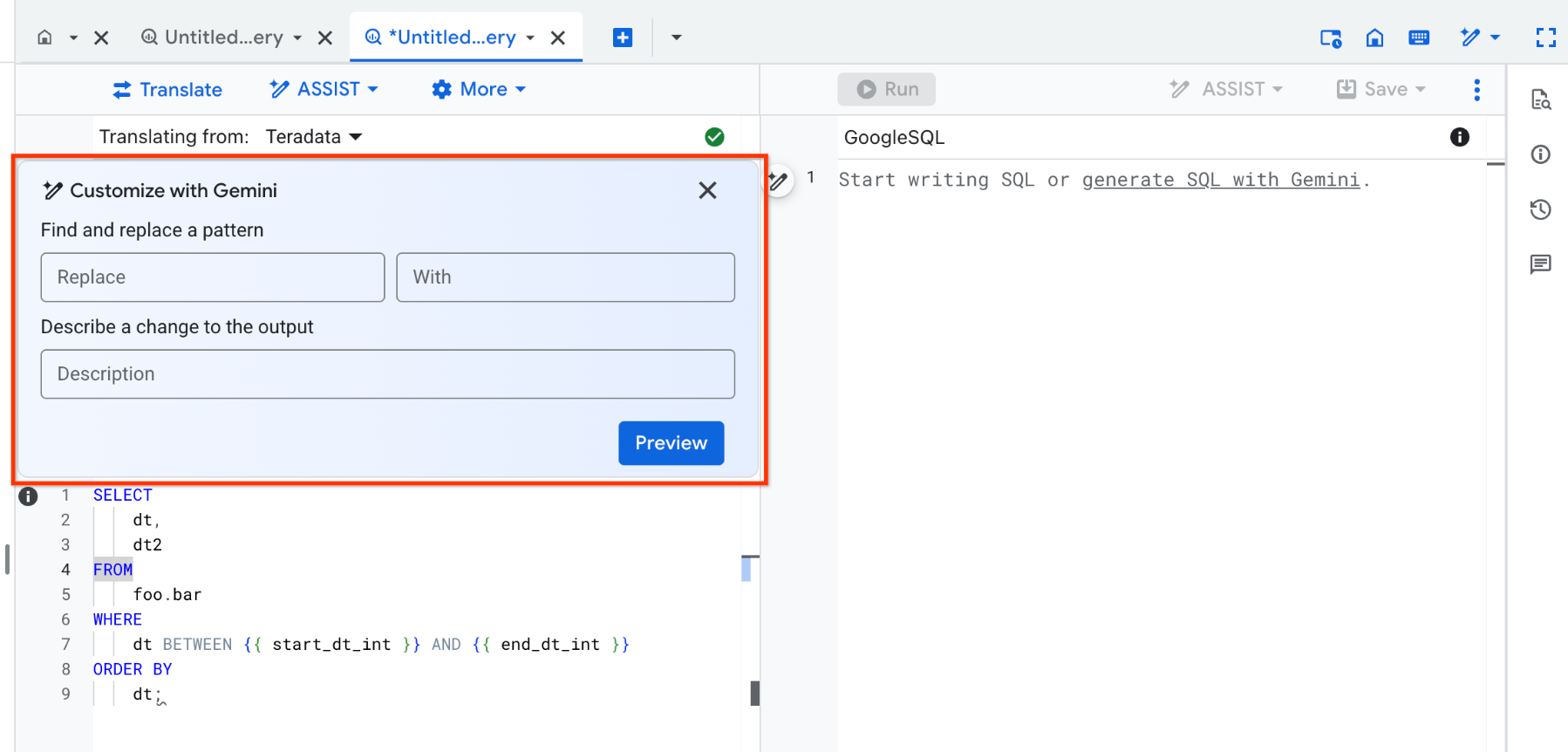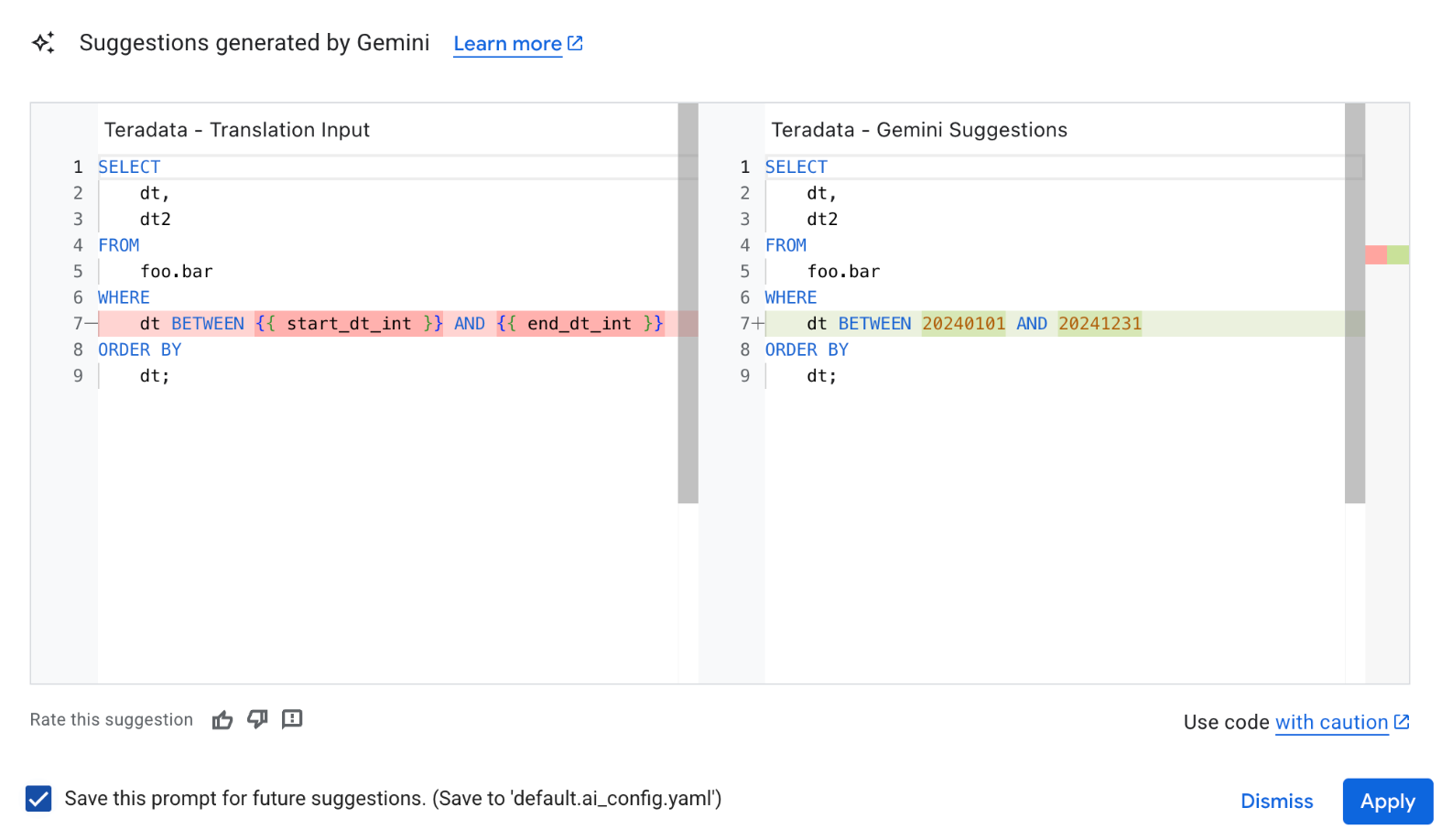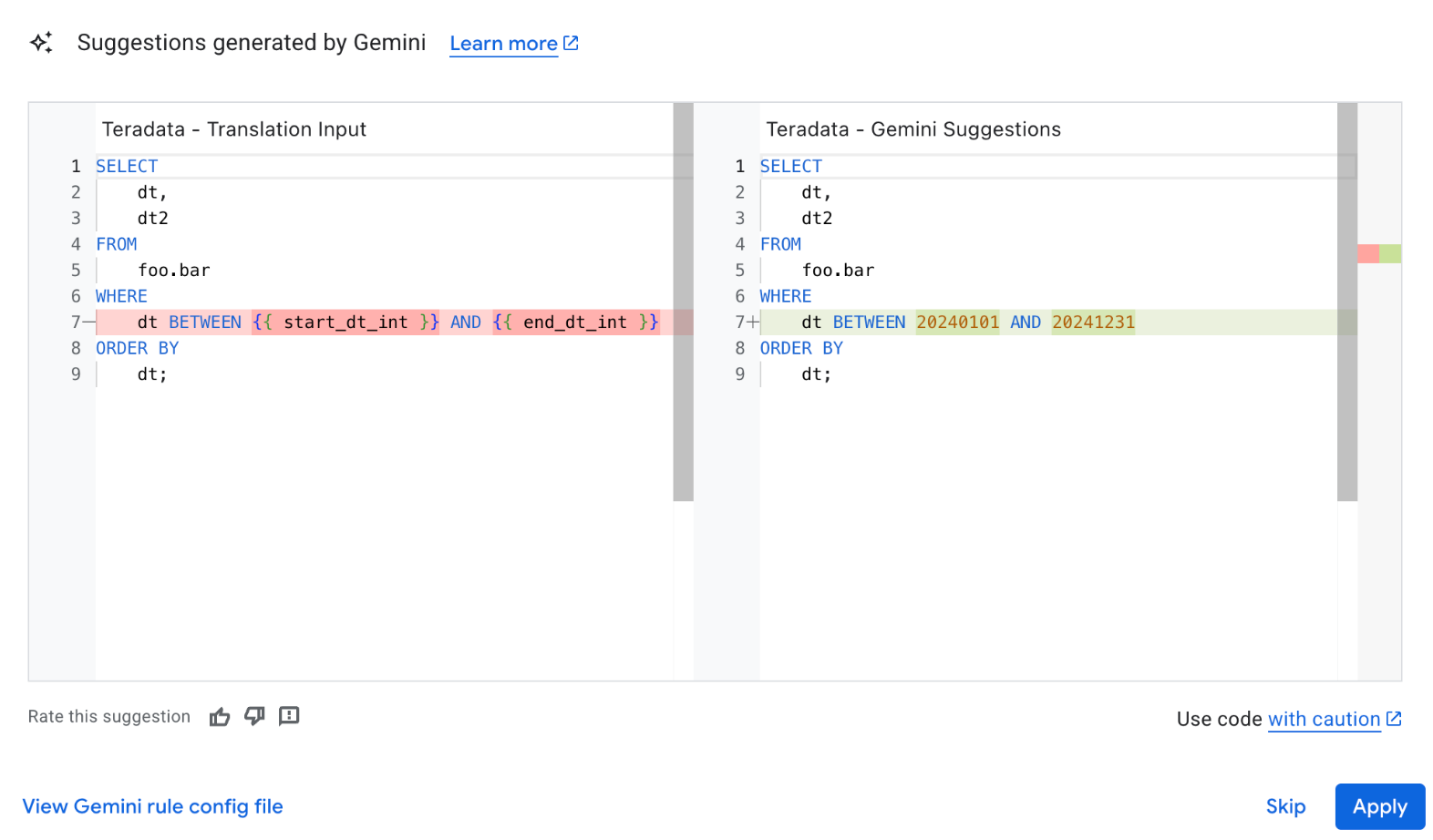Translate queries with the interactive SQL translator
This document describes how to translate a query from a different SQL dialect into a GoogleSQL query by using the BigQuery interactive SQL translator. The interactive SQL translator can help reduce time and effort when you migrate workloads to BigQuery. This document is intended for users who are familiar with the Google Cloud console.
If your location is supported, you can use the translation rule feature to customize the way the interactive SQL translator translates SQL.
Before you begin
If your Google Cloud CLI project was created before February 15, 2022, enable the BigQuery Migration API as follows:
In the Google Cloud console, go to the BigQuery Migration API page.
Click Enable.
Permissions and roles
This section describes the Identity and Access Management (IAM) permissions that you need in order to use the interactive SQL translator, including the predefined IAM roles that grant those permissions. The section also describes the permissions needed to configure additional translation configurations.
Permissions to use the interactive SQL translator
To get the permissions that
you need to use the interactive translator,
ask your administrator to grant you the
MigrationWorkflow Editor (roles/bigquerymigration.editor)
IAM role on the parent resource.
For more information about granting roles, see Manage access to projects, folders, and organizations.
This predefined role contains the permissions required to use the interactive translator. To see the exact permissions that are required, expand the Required permissions section:
Required permissions
The following permissions are required to use the interactive translator:
-
bigquerymigration.workflows.create -
bigquerymigration.workflows.get
You might also be able to get these permissions with custom roles or other predefined roles.
Permissions to configure additional translation configurations
You can configure additional translation configurations using the Translation Config ID and Translation Configuration Source Location fields in the translation settings. To configure these translation configurations, you need the following permissions:
bigquerymigration.workflows.getbigquerymigration.workflows.list
The following predefined IAM role provide the permissions that you need to configure additional translation configurations:
roles/bigquerymigration.viewer
For more information about BigQuery IAM, see Access control with IAM.
Supported SQL dialects
The BigQuery interactive SQL translator can translate the following SQL dialects into GoogleSQL:
- Amazon Redshift SQL
- Apache HiveQL and Beeline CLI
- IBM Netezza SQL and NZPLSQL
- Teradata and Teradata Vantage:
- SQL
- Basic Teradata Query (BTEQ)
- Teradata Parallel Transport (TPT)
Additionally, translation of the following SQL dialects is supported in preview:
- Apache Spark SQL
- Azure Synapse T-SQL
- Greenplum SQL
- IBM DB2 SQL
- MySQL SQL
- Oracle SQL, PL/SQL, Exadata
- PostgreSQL SQL
- Trino or PrestoSQL
- Snowflake SQL
- SQL Server T-SQL
- SQLite
- Vertica SQL
Handling unsupported SQL functions with helper UDFs
When translating SQL from a source dialect to BigQuery, some functions might not have a direct equivalent. To address this, the BigQuery Migration Service (and the broader BigQuery community) provide helper user-defined functions (UDFs) that replicate the behavior of these unsupported source dialect functions.
These UDFs are often found in the bqutil public dataset, allowing translated queries to initially reference them using the format bqutil.<dataset>.<function>(). For example, bqutil.fn.cw_count().
Important considerations for production environments:
While bqutil offers convenient access to these helper UDFs for initial translation and testing, direct reliance on bqutil for production workloads is not recommended for several reasons:
- Version control: The
bqutilproject hosts the latest version of these UDFs, which means their definitions can change over time. Relying directly onbqutilcould lead to unexpected behavior or breaking changes in your production queries if a UDF's logic is updated. - Dependency isolation: Deploying UDFs to your own project isolates your production environment from external changes.
- Customization: You might need to modify or optimize these UDFs to better suit your specific business logic or performance requirements. This is only possible if they are within your own project.
- Security and governance: Your organization's security policies might restrict direct access to public datasets like
bqutilfor production data processing. Copying UDFs to your controlled environment aligns with such policies.
Deploying helper UDFs to your project:
For reliable and stable production use, you should deploy these helper UDFs into your own project and dataset. This gives you full control over their version, customization, and access. For detailed instructions on how to deploy these UDFs, refer to the UDFs deployment guide on GitHub. This guide provides the necessary scripts and steps to copy the UDFs into your environment.
Locations
The interactive SQL translator is available in the following processing locations:
| Region description | Region name | Details | |
|---|---|---|---|
| Asia Pacific | |||
| Delhi | asia-south2 |
||
| Hong Kong | asia-east2 |
||
| Jakarta | asia-southeast2 |
||
| Melbourne | australia-southeast2 |
||
| Mumbai | asia-south1 |
||
| Osaka | asia-northeast2 |
||
| Seoul | asia-northeast3 |
||
| Singapore | asia-southeast1 |
||
| Sydney | australia-southeast1 |
||
| Taiwan | asia-east1 |
||
| Tokyo | asia-northeast1 |
||
| Europe | |||
| Belgium | europe-west1 |
|
|
| Berlin | europe-west10 |
||
| EU multi-region | eu |
||
| Finland | europe-north1 |
|
|
| Frankfurt | europe-west3 |
||
| London | europe-west2 |
|
|
| Madrid | europe-southwest1 |
|
|
| Milan | europe-west8 |
||
| Netherlands | europe-west4 |
|
|
| Paris | europe-west9 |
|
|
| Stockholm | europe-north2 |
|
|
| Turin | europe-west12 |
||
| Warsaw | europe-central2 |
||
| Zürich | europe-west6 |
|
|
| Americas | |||
| Columbus, Ohio | us-east5 |
||
| Dallas | us-south1 |
|
|
| Iowa | us-central1 |
|
|
| Las Vegas | us-west4 |
||
| Los Angeles | us-west2 |
||
| Mexico | northamerica-south1 |
||
| Northern Virginia | us-east4 |
||
| Oregon | us-west1 |
|
|
| Québec | northamerica-northeast1 |
|
|
| São Paulo | southamerica-east1 |
|
|
| Salt Lake City | us-west3 |
||
| Santiago | southamerica-west1 |
|
|
| South Carolina | us-east1 |
||
| Toronto | northamerica-northeast2 |
|
|
| US multi-region | us |
||
| Africa | |||
| Johannesburg | africa-south1 |
||
| MiddleEast | |||
| Dammam | me-central2 |
||
| Doha | me-central1 |
||
| Israel | me-west1 |
||
By default, the translation rule feature is available in the following processing locations:
us(US multi-region)eu(EU multi-region)us-central1(Iowa)europe-west4(Netherlands)
Gemini-based translation configurations are only available in specific processing locations. For more information, see Google model endpoint locations
Translate a query into GoogleSQL
Follow these steps to translate a query into GoogleSQL:
In the Google Cloud console, go to the BigQuery page.
In the Editor pane, click More, and then select Translation settings.
For Source dialect, select the SQL dialect that you want to translate.
Optional. For Processing location, select the location where you want the translation job to run. For example, if you are in Europe and you don't want your data to cross any location boundaries, select the
euregion.Click Save.
In the Editor pane, click More, and then select Enable SQL translation.
The Editor pane splits into two panes.
In the left pane, enter the query you want to translate.
Click Translate.
BigQuery translates your query into GoogleSQL and displays it in the right pane. For example, the following screenshot shows translated Teradata SQL:

Optional: To run the translated GoogleSQL query, click Run.
Optional: To return to the SQL editor, click More, and then select Disable SQL translation.
The Editor pane returns to a single pane.
Use Gemini with the interactive SQL translator
You can configure the interactive SQL translator to adjust how the interactive SQL translator translates your source SQL. You can do so by providing your own rules for use with Gemini in a YAML configuration file, or by providing a configuration YAML file containing SQL object metadata or object mapping information.
Create and apply Gemini-enhanced translation rules
You can customize the way the interactive SQL translator translates SQL by creating translation rules. The interactive SQL translator adjusts its translations based on any Gemini-enhanced SQL translation rules that you assign to it, letting you customize the translation results based on your migration needs. This feature is supported only in certain locations.
To create a Gemini-enhanced SQL translation rule, you can either create it in the console, or create a configuration YAML file and upload it to Cloud Storage.
Console
To create a Gemini-enhanced SQL translation rule for the input SQL, write an input SQL query in the query editor, then click ASSIST > Customize. (Preview)

Similarly, to create a Gemini-enhanced SQL translation rule for the output SQL, run an interactive translation, then click ASSIST > Customize this translation.

When the Customize menu appears, continue with the following steps.
Use one or both of the following prompts to create a translation rule:
In the Find and replace a pattern prompt, specify a SQL pattern that you want to replace in the Replace field, and a SQL pattern to replace it in the With field.
A SQL pattern can contain any number of statements, clauses, or functions in a SQL script. When you create a rule using this prompt, the Gemini enhanced SQL translation identifies any instances of that SQL pattern in the SQL query and dynamically replaces it with another SQL pattern. For example, you can use this prompt to create a rule that replaces all occurrences of
months_between (X,Y)withdate_diff(X,Y,MONTH).In the Describe a change to the output field, type a change to the SQL translation output in natural language.
When you create a rule using this prompt, the Gemini-enhanced SQL translation identifies the request and makes the specified change to the SQL query.
Click Preview.
In the Suggestions generated by Gemini dialog, review the changes made by the Gemini-enhanced SQL translation to the SQL query based on your rule.

Optional: To add this rule for use with future translations, select the Save this prompt... checkbox.
Rules are saved in the default configuration YAML file, or
__default.ai_config.yaml. This configuration YAML file is saved to the Cloud Storage folder as specified in the Translation Configuration Source Location field in the translation settings. If the Translation Configuration Source Location isn't already set, a folder browser appears and lets you select one. A configuration YAML file is subject to configuration file size limitations.To apply the suggested changes to the SQL query, click Apply.
YAML
To create a Gemini-enhanced SQL translation rule, you can create a Gemini-based configuration YAML file and upload it to Cloud Storage. For more information, see Create a Gemini-based configuration YAML file.
Once you have uploaded a Gemini-enhanced SQL translation rule and uploaded it to Cloud Storage, you can apply the rule by doing the following:
In the Google Cloud console, go to the BigQuery page.
In the query editor, click More > Translation settings.
In the Translation Configuration Source Location field, specify the path to the Gemini-based YAML file stored in a Cloud Storage folder.
Click Save.
Once saved, run an interactive translation. The interactive translator suggests changes to your translations based on the rules in your configuration YAML file if one is available.
If a Gemini suggestion is available for the input based on your rule, then the Preview suggested changes dialog appears and shows possible changes to the translation input. (Preview)
If a Gemini suggestion is available for the output based on your rule, a notification banner appears in the code editor. To review and apply these suggestions, do the following:
Click Assist > View suggestions on either side of the code editor to revisit the suggested changes to the corresponding query.

In the Suggestions generated by Gemini dialog, review the changes made by Gemini to the SQL query based on your translation rule.
To apply the suggested changes to the translation output, click Apply.
Update Gemini-based configuration YAML file
To update an existing configuration YAML file, do the following:
On the Suggestions generated in Gemini dialog, click View Gemini rule config file.
When the configuration editor appears, select the configuration YAML file that you want to edit.
Make the change and click Save.
Close the YAML editor by clicking Done.
Run an interactive translation to apply the updated rule.
Explain a translation
After running an interactive translation, you can request a Gemini-generated text explanation. The generated text includes a summary of the translated SQL query. Gemini also identifies translation differences and inconsistencies between the source SQL query and the translated GoogleSQL query.
To get Gemini-generate SQL translation explanation, do the following:
To create a Gemini-generated SQL translation explanation, click Assist, and then click Explain this translation.

Translate with a batch translation configuration ID
You can run an interactive query with the same translation configurations as a batch translation job by providing a batch translation configuration ID.
- In the query editor, click More > Translation settings.
In the Translation Configuration ID field, provide a batch translation configuration ID to apply the same translation configuration from a completed BigQuery batch migration job.
To find a job's batch translation configuration ID, select a batch translation job from the SQL translation page, and then click the Translation Configuration tab. The batch translation configuration ID is listed as Resource name.
Click Save.
Translate with additional configurations
You can run an interactive query with additional translation configurations by specifying configuration YAML files stored on a Cloud Storage folder. Translation configurations might include SQL object metadata or object mapping information from the source database that can improve translation quality. For example, include DDL information or schemas from the source database to improve interactive SQL translation quality.
To specify translation configurations by providing a location to the translation configuration source files, do the following:
- In the query editor, click More > Translation settings.
In the Translation Configuration Source Location field, specify the path to the translation configuration files stored in a Cloud Storage folder.
The BigQuery interactive SQL translator supports metadata ZIP files containing translation metadata and object name mapping. For information on how to upload files to Cloud Storage, see Upload objects from a filesystem.
Click Save.
Configuration file size limitations
When you use a translation configuration file with the BigQuery interactive SQL translator, the compressed metadata file or YAML config file must be smaller than 50 MB. If the file size exceeds 50 MB, the interactive translator skips that configuration file during translation and produces an error message similar to the following:
CONFIG ERROR: Skip reading file "gs://metadata-file.zip". File size (150,000,000 bytes)
exceeds limit (50 MB).
One method to reduce metadata file size is to use the --database or --schema
flags to only extract metadata for databases or schemas that are relevant for
the translation input queries. For more information about using these flags when
you generate metadata files, see Global flags.
Troubleshoot translation errors
The following are commonly encountered errors when using the interactive SQL translator.
RelationNotFound or AttributeNotFound translation issues
To ensure the most accurate translation,
you can input the data definition language (DDL) statements for any tables used
in a query prior to the query itself. For example, if you want
to translate the Amazon Redshift query select table1.field1, table2.field1
from table1, table2 where table1.id = table2.id;, you would input the
following SQL statements into the interactive SQL translator:
create table schema1.table1 (id int, field1 int, field2 varchar(16));
create table schema1.table2 (id int, field1 varchar(30), field2 date);
select table1.field1, table2.field1
from table1, table2
where table1.id = table2.id;
Pricing
There is no charge to use the interactive SQL translator. However, storage used to store input and output files incurs the normal fees. For more information, see Storage pricing.
What's next
Learn more about the following steps in data warehouse migration:
- Migration overview
- Migration assessment
- Schema and data transfer overview
- Batch SQL translation
- Data pipelines
- Data security and governance
- Data validation tool
